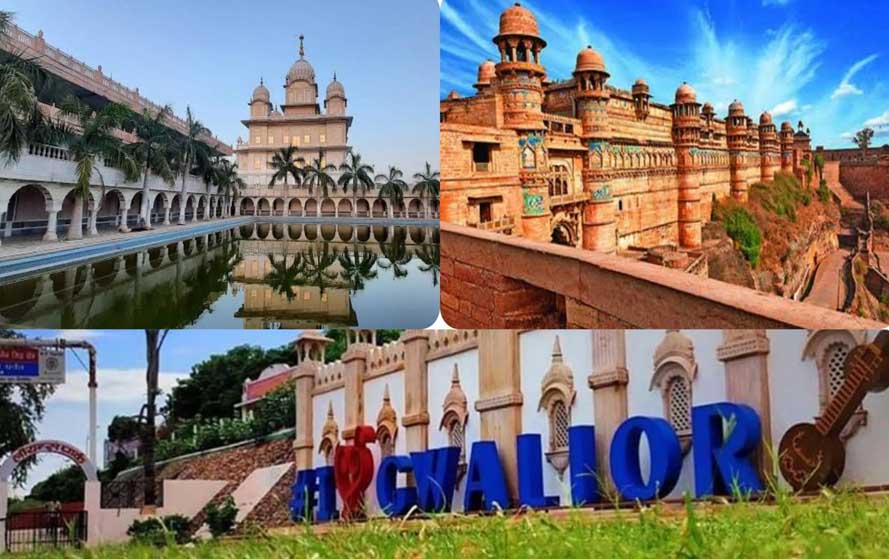


The Fort - Massive Gwalior Fort, popularly called the Gibraltar of India, overlooks the city. Emperor Babur reputedly described it as "the pearl in the necklace of the forts of Hind." This fort's architecture is unique. It shows Chinese influence on Indian architecture, as Chinese dragons have been crafted at the hilt of the pillars. This influence was because of trade between China and India during that period. After the death of Sher Shah Suri in 1545, who was ruling North India at that time, his son Islam Shah shifted his capital from Delhi to Gwalior and constructed 'Sher Shah Mandir' or Palace/Fort in the memory of his father Sher Shah Suri. Islam Shah operated from Gwalior till his death in 1553.
Islam Shah had appointed the Hindu warrior 'Hemu' or Hem Chandra Vikramaditya as his Prime Minister in Sher Shah Fort for the first time, who later on became the Vikramaditya king at Delhi and established 'Hindu Raj' in North India, by virtue of winning 22 battles continuously from Punjab to Bengal and defeating Akbar's army in Agra and Delhi on 6 October 1556. He is also known in history as Samrat Hem Chandra Vikramaditya.
View from the summit of the Gwalior Fort showing the palace of the Maharajah of Scindia. Circa 1882. According to history, the original fort of Gwalior was founded by the Bargujar Kings during the 34th/35th century of Kali yuga as per puranas available with them. His palace is the most interesting example of early Hindu work of its class in India. Another palace of even greater extent was added to this in 1516. The Mughal emperors Jahangir and Shah Jahan added palaces to these two, the whole making a group of edifices unequalled for picture sequences and interest by anything of their class in central India. Among the apartments in the palace was the celebrated chamber, named the Baradari, supported on 12 columns, and 45 ft (15 m) square, with a stone roof, forming one of the most beautiful palace-halls in the world. It was, besides, singularly interesting from the expedients to which the Hindu architect was forced to resort to imitate the vaults of the Muslims. Of the buildings, however, which so excited the admiration of the first Mughal emperor Babur, probably little now remains.
Telika Mandir, 8th Century - The Telika Mandir or 'oil-man's temple', owes its name to Teli, a term for an oil grinder or oil dealer. Many suggestions have been put forward to explain this name historically, but in actual fact the name is not old, the temple being used for processing oil before the British occupied the fort and used the building, albeit temporarily, as a coffee shop. The Telika Mandir is the loftiest temple among all the buildings in Gwalior fort with a height of about 30m. The temple consists of a garbhagriha, that is sanctum proper for the deity, and an antarala to enter into the temple. It can be approached by a flight of steps provided on the eastern side. The most striking feature of the temple is the wagon-vaulted roof, a form used over rectangular shrines which normally accommodated a row of Mother Goddesses. The goddesses from the interior vanished centuries ago and have not been traced, even in fragments. The exterior walls of the temple are richly decorated with sculptures, many of which are damaged; the niches, shaped like temples, are empty. The building carries a dedicatory inscription to the goddess in a niche on the southern side, but otherwise does not have any history. The architectural style, discussed by a number of architectural historians, points to a date in the late eighth century. The building was thus erected just as the Gurjara Pratihāras were asserting their power over central India. The entrance gateway on the eastern side is a later addition of the British period, made by Major Keith in 1881. It was erected as a way of saving various historic pillars and other pieces no longer in their original context.
Sasbahu Temple, also called the Sas-Bahu Mandir, is an 11th-century twin temple in Gwalior, Madhya Pradesh, India. Near the Gwalior Fort and dedicated to Vishnu in his Padmanabha form, like most Hindu and Jain temples in this region, it is mostly in ruins and was badly damaged from numerous invasions and Hindu-Muslim wars in the region. It was built in 1093 by King Mahipala of the Kachchhapaghata dynasty, according to an inscription found in the larger of the twin temple. The twin temples are situated in the Gwalior Fort

Ujjain is a city that blends spirituality, history, and culture in a unique way. With our specialized Ujjain Tour & Travel services, you can experience the divine essence of this holy city without any stress.
Read MoreDesigned and Developed By PDC TECHONOLOGIES